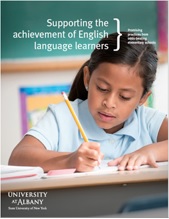20-20 NYKids Taking Stock: Supporting ELLs and Preparing Them for College or Career
By Lisa Yu
Through this third installment in the NYKids 20-20 blog series, we look back at 15 years of NYKids’ research in schools across New York State to revisit past findings from odds-beating schools and explore how educators support English language learners (ELLs) and prepare them for college or career.
The Increasing Need to Support ELL Students
As one of the top 13 states with the highest density of ELLs in its schools, New York State educators serve almost 250,000 ELLs that comprise approximately 9% of the total school population. In the past five years, the number of ELLs enrolled in New York K-12 schools has increased by 11%, reflecting a trend toward more culturally and linguistically diverse classrooms in the state and nation.
Prior NY Kids research indicates that while some ELLs arrive in school well-prepared to succeed, others face a variety of academic, social-emotional, or physical challenges that need to be addressed. State policymakers have sought to revise relevant policies to better serve this growing population. For example, in 2014, substantial amendments to CR Part 154 were made, which addressed the needs of ELLs in early childhood settings, the provision of professional development opportunities to prepare qualified ELL teachers, and the use of appropriate programs, among others.
Findings from the 2015-16 ELL Elementary Study
To gain a better understanding of how educators were addressing ELL needs under the amended CR Part 154, the NYKids team investigated 6 elementary schools during the 2015-16 school year. The six schools in the study showed evidence of being positive outliers (i.e. with statistically significant better student performance across multiple subjects and grade levels). The study was framed by social-ecological theory, which highlights the relationships among and between contexts such as classrooms, schools, districts, and communities. NYKids researchers found four elements common and salient to ELL performance in the schools studied. They are:
- A welcoming school climate in a culture that emphasizes high expectations and equitable access to rigorous curricula;
- Inclusive, individualized, and culturally responsive practices offered by skilled and dedicated English New Language (ENL) teacher and other educators and support staff;
- Team configurations and communications to serve ELLs and their families; and
- A holistic approach to leadership and capacity building for ELLs’ success.
The study found that these elements work together in an interdependent system across classrooms, schools, and districts, and are responsive to community needs. At the classroom level, ENL and mainstream teachers collaborate to provide culturally responsive instruction to facilitate ELLs’ development of language and content knowledge. At the school level, teachers and school leaders work together to develop a welcoming school climate by providing ELLs and their families equitable access to education resources. And at the district level, leaders make efforts to increase the overall capacity of faculty by hiring teachers with ENL certifications/expertise and by offering professional development opportunities to ENL teachers.
New Opportunities and Challenges for All Teachers to Serve ELLs
In 2014, The New York State Education Department (NYSED) offered the Blueprint for English Language Learners Success as a resource and to reinforce the idea that “all teachers are teachers of ELLs”. This blueprint articulated the expectation that every teacher be skilled in supporting ELLs to acquire content knowledge and develop English language proficiency.
Meanwhile, the state encouraged mainstream teachers to obtain ENL certifications by changing certification requirements and providing tuition-free programs. For example, certified content area teachers could, under the new certification pathways, obtain a supplementary TESOL certificate by completing 12 semester hours of coursework and passing the TESOL content area test. Some of those teachers who had opportunities to enroll in approved programs, such as the Clinically Rich Intensive Teacher Institute (CR-ITI) , would pay no tuition as long as they committed to continue working in the same districts.
Findings from the 2017-18 College and Career Readiness Study: Asset-Based Approaches and ENL Professional Development for All
As one of its major goals, the NYKids project has always endeavored to contribute insights into understanding the development of socio-economically, culturally, and linguistically diverse youth and to offer research-based recommendations to support their success in school. To this end, in 2017-18, the NYKids team conducted a College and Career Readiness study and explored how educators in odd-beating schools prepare their students for college or career and adapt their processes and practices for cultural, linguistic, and socio-economic diversity.
We found two practices that leaders and educators in these schools use to better meet their ELLs’ academic and social-emotional needs.
- First, educators in odds-beating schools, like Port Chester, adopt an asset-based approach to help their ELLs acquire content knowledge and develop English language proficiency. They do this based on their ELLs’ existing knowledge and by tapping into their ethnic and linguistic backgrounds when they can.
As one teacher in Port Chester High School put it, “That [adjusting to student needs and circumstances] is what we’re hardwired for…”

- Second, leaders in odds-beating schools ensure high-quality instruction and the delivery of appropriate services for ELLs through their staffing and scheduling practices. For example, at Freeport, Bilingual Education and ENL-trained teachers and staff are a top staffing priority. When candidates do not have the requisite bilingual or ENL teaching certificates, the district provides support for those educators who are willing to acquire an ENL or bilingual extension certificate.
As a school leader in Freeport High School explained, “[District leaders] want to know that you can handle this population, that you have experience with this population and have knowledge about it.”
The practices NYKids identified in the most recent study echoed the findings from the NYKids’ 2015-16 elementary school study in that culturally responsive instructional practices and appropriate staffing were key. However, with a closer look, we see through the 2017-18 College and Career Readiness study that leaders and educators are enhancing how they serve ELLs at the secondary level in some specific ways. These enhancements include:
- Educators aim to not only support ELLs’ socialization into mainstream classrooms, but help them to sustain their own cultural and linguistic identity. For example, in Freeport High School, a “Spanish for Native Speakers” course was offered to help Spanish-speaking students develop advanced reading and writing skills in their native language.
- ENL, mainstream teachers, and other specialists work in concert to provide support and adapt their practices to meet the needs of ELLs. To do this successfully, leaders schedule classes and use specialist staff creatively to meet every child’s needs. For example, a teacher in Port Chester High School explained:
We have foreign born, we have mainstream, and we have special education students, and so depending on where that child is, you depend on different teachers or staff members to go to regarding that child.
Looking forward: NYKids Student Study
At the end of 2019, the NYKids team embarked on Phase II of the College and Career Readiness study to hear students’ voices about their high school experiences and post-high school plans. As ENL education is one of the hottest topics in the education arena, having the student perspective will offer critical insight into how schools with above-predicted student outcomes meet ELL students’ various academic and social-emotional needs and prepare them to succeed in school as well as in their future career. Stay tuned for new findings from this study in the coming months.
If you’d like to read more about NYKids research on ELL education or any other topic, please visit us on the web, Facebook, and Twitter, and sign-up for our newsletters to learn the latest about our current study and for future 20-20 blogs.


